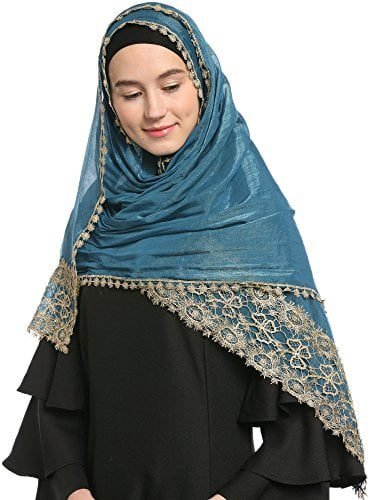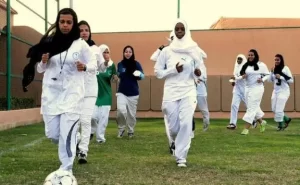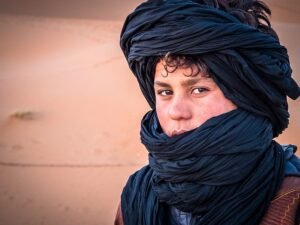There are many types of veils that differ from one region to another, either due to local cultural influences or because they follow a different sect of Islam. Most people, when pointing out the headscarves worn by Muslims, are likely unable to discern the various types of Islamic veils.
Burka

This is often the one that generates the most confusion in the media. The burka is a headscarf that covers the entire body with a single fabric, leaving a mesh for viewing. I have never seen this being worn anywhere outside of Afghanistan, some communities in Pakistan and Iran, and (formerly) the rest of Central Asia (it’s noteworthy that these three countries mentioned earlier are not Arab countries; they are just Muslim countries). You will never see this type of headscarf in the West, despite calls for a “burka ban” or similar measures.
This was commonly used throughout the Eastern Islamic world; however, its usage has diminished over the years, and the only country where it is still prominent is Afghanistan. It was only recently discontinued in Soviet Central Asia due to Soviet repression, but it used to exist there.
Contrary to what most people might think, the burka does not originate from Islam but rather from ancient times during the Zoroastrian empires that ruled this region. This covering used to be a status symbol for women, indicating that the wearer was a free woman of high standing. In fact, it was forbidden for common and slave women to wear the burka due to this fact.
Niqab

This is often confused with a burka. It is a complete covering that leaves a slit for the eyes to see. The niqab is mainly worn in Arab countries, particularly Saudi Arabia and other religious communities in Gulf countries. The niqab is not a requirement in Islam, as most scholars agree. Only a small minority of scholars in the Hanbali school of thought believes that the niqab is truly obligatory.
This type of headscarf has its origins in the Byzantine Empire, where it was adopted by Arab communities when they had close contact with them. The authentic Hadith of the Prophet (SAW) even prohibits it on certain occasions:
“It is forbidden for a woman in the state of Ihram to cover her face.” -Narrated by Sahih Bukhari-
The niqab itself, from what I’ve seen, is very rare for Muslim women in Western countries to wear. The “threat” of women wearing niqab in Western countries to destroy the “Western civilization” is overly exaggerated.
Hijab

The most common type of headscarf for Muslim women is the hijab, and it has many different styles in which it is worn.
This style of scarf leaves the face visible while covering the hair and neck. This headscarf is called the hijab and is not known (incorrectly) as a “burqa” or “niqab.” I find it really hard to justify that Muslim women are oppressed when they wear the hijab.
The hijab is a symbol of women’s empowerment. It is a statement, to those around her, that she is not just a sexual symbol for random men to look at and admire. It is a statement that says the wearer is not a cheap woman who doesn’t care if random men get sexual excitement from looking at her. It is a symbol of status, modesty, and faith, just as it is in other religions that use veils, such as traditional Christianity and Judaism (i.e., not the modern and diluted version).
Why didn’t this debate exist before? Why didn’t we see Jews in the time of the Prophet, slandering Islam for requiring Muslim women to cover their heads? This is because at that time, the headscarf was almost universal and was worn in the cultures of Western Eurasia until recently.
Shayla: Rectangular Elegance in the Gulf

The shayla, a rectangular fabric with great popularity in the Gulf region, presents itself as an elegant and versatile choice for women who choose to cover themselves. This scarf is wrapped around the head, providing complete coverage, and is secured with pins on the shoulders, ensuring a secure fit. Its rectangular design allows for various ways of wearing it, reflecting both the fashion and tradition of the region. The shayla, in addition to fulfilling its functional purpose, becomes an expression of style and culture.
Jimar: Graceful Waist Coverage

The jimar, similar to a cape falling just above the waist, offers complete coverage of the hair, neck, and shoulders while leaving the face uncovered. Its design reflects graceful elegance and practicality. This garment not only provides modesty in attire but also allows freedom of movement without compromising essential coverage. The jimar stands out for its adaptability and its ability to combine functionality with a touch of style.
Chador: Complete Iranian Cape for Elegance

The chador, a complete cape, is commonly used among Iranian women when they are outside the home, standing out for its grace and elegance. This garment extends from the head to the feet, completely covering the body and creating an image of modesty and devotion. Often, the chador is accompanied by a smaller scarf underneath, adding layers to the attire and allowing for an additional expression of personal style. The diversity of styles and meanings that the chador can adopt reflects the richness of cultural traditions and the individuality of those who wear it.
The Different Types of Islamic Veils
Within Islam, the use of the veil is a broad and diverse practice. Across different regions and Muslim cultures, we find a variety of styles and veil designs that reflect the individuality and identity of the women who wear them. From the traditional hijab to the elegant niqab and the complete coverage of the burka, each type of veil has its own characteristics and meanings.
These different types of Islamic veils not only adhere to religious precepts but also manifest local culture and traditions. Through their diversity, Islamic veils invite us to appreciate the richness and complexity of Muslim faith and identity, reminding us of the importance of approaching religious practices with respect and understanding.
• Interactive classes: Our classes are dynamic and participatory. You will learn in a fun and effective way.
• Native teachers: We have native Arabic instructors who will guide you through every step of the learning process.
• Flexibility: You will be able to study from the comfort of your home and adjust your schedule according to your availability.



